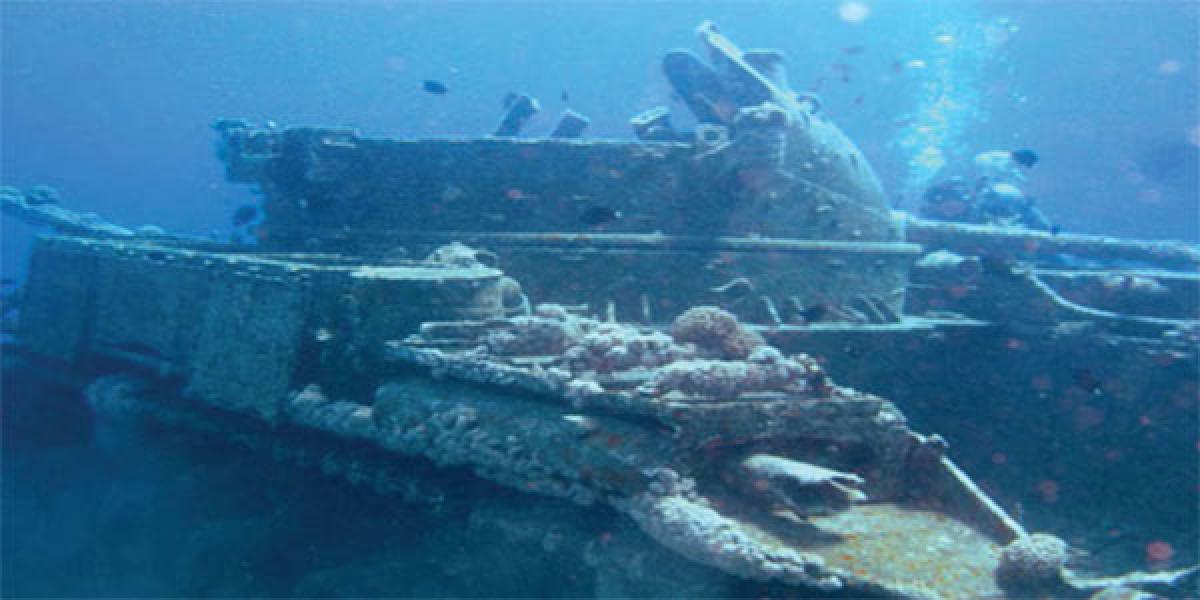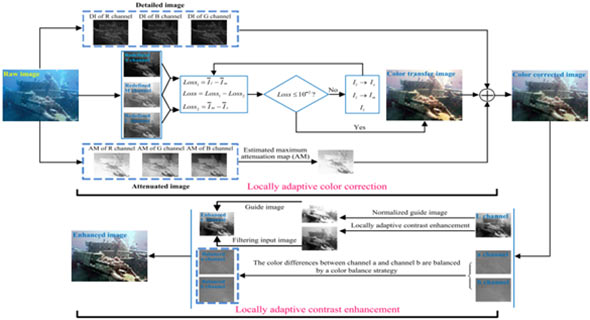
Contributed by Dr. Weidong Zhang, based on the IEEEXplore® article, “Underwater Image Enhancement via Minimal Color Loss and Locally Adaptive Contrast Enhancement”, published in the IEEE Transactions on Image Processing, 2022.
Introduction
Underwater imaging plays a significant role in marine scientific expeditions, underwater robotics, and underwater object recognition [1,2]. Underwater image is an essential information carrier for perceiving and understanding underwater environments. Unfortunately, the color and contrast of underwater images are dramatically degraded due to wavelength-dependent light absorption and scattering, insufficient lighting, and low-end underwater imaging devices [3,4]. More specifically, the selective absorption of light tends to cause color deviations in underwater images. Meanwhile, light scattering easily causes blurry details and low contrast. To solve these challenging issues, many underwater image enhancement (UIE) methods have been developed [5,6].
In the early stage, specialized hardware-based methods employed multiple images or polarization imaging to improve the visibility of underwater images. However, these complex devices are difficult to capture image sequences. In addition, restoration-based methods are difficult to accurately estimate the parameters of underwater imaging models. Enhancement-based methods have remarkable performance for enhancing the contrast and brightness of underwater images. However, they tend to introduce over-enhancement and over-saturation. In terms of learning-based methods high-quality training images are still scarce.
To advance the development of underwater image enhancement, we present a Minimal Color Loss and Locally Adaptive Contrast Enhancement method for underwater image enhancement, called MLLE. The proposed MLLE explores the color correction and contrast improvement of underwater images, including two main stages: locally adaptive color correction and locally adaptive contrast enhancement. In Fig. 1, the results are enhanced by MLLE for several underwater images sampled from different underwater scenes. Without fine-tuning the parameters, MLLE consistently yields visually pleasing results, benefiting from our designs.

Fig. 1. Samples of our enhanced results. From left to right are the results of different methods of enhancement.
The Proposed Method
In this work, the underwater image enhancement in Fig. 2, includes two main stages: locally adaptive color correction and locally adaptive contrast enhancement. In the former stage, we first obtain the color transfer image from the input image based on a minimum information loss principle. Meanwhile, we present a maximum attenuation map-guided fusion strategy that uses the color transfer image to locally adjust the color and details of the input image. In the latter stage, introduce the integral and squared integral maps to compute the mean and variance of local image blocks, which are used to improve the contrast of the input image. A color balance strategy is also presented to balance the color.
The proposed MLLE is different from existing methods. We emphasize the contributions of this work as follows.
- We propose an efficient and robust UIE method. Extensive experiments demonstrate the superior performance of our method. Our method enjoys fast processing speed and is beneficial for several underwater vision tasks. Besides, this method also generalizes well to the images taken in foggy and sandstorm environments.
- We propose a locally adaptive color correction method built on the minimum color loss principle and the maximum attenuation map-guided fusion strategy. In comparison to existing color correction methods, our method reduces the color loss of the color corrected image by considering the attenuation characteristics of different color channels.
- We propose a locally adaptive contrast enhancement method, which introduces the integral and squared integral maps to efficiently compute the mean and variance of local image blocks for contrast adjustment. Compared with existing methods, our method reduces the under- and over-enhancement of the enhanced results.

Fig. 2. Flowchart of the proposed method.
Locally Adaptive Color Correction
Unlike previous color correction methods, we propose a LACC method consisting of two core steps: 1) we first derive a color transfer image from the raw underwater image using the minimum color loss principle, avoiding using a land image as the reference image; and 2) we propose a maximum attenuation map-guided fusion method to exploit the color transfer image while locally adjusting the color and details of the raw underwater image to obtain a color corrected image, which considers both the light absorption and the loss of contour information induced by light forward scattering.
Locally Adaptive Contrast Enhancement
Besides color correction, we propose a locally adaptive contrast enhancement to improve the contrast of underwater images. On the one hand, we improve the contrast of the luminance channel L. On the other hand, we balance the color differences between the a and b color channels in the CIELAB color space. Note that the luminance and color channels are independent of each other. We employ different strategies for different channels according to their characteristics.
Experimental Results
To demonstrate the effectiveness of our method, we test our method on UCCS, UIQS, and UIEB as shown in Fig. 3. Our method has surpassed popular image enhancement methods. In comparison, our method effectively removes unnatural colors and improves visibility without obvious over-enhancement, under-enhancement, and local darkness.

Fig. 3. Samples of our enhanced results (bottom) for diverse raw underwater images (top). Raw underwater images in (a) and (b) are sampled from UCCS. Raw underwater images in (c) and (d) are sampled from the UIQS. Raw underwater images in (e) and (f) are sampled from the UIEB. Without fine-tuning the parameters, our method consistently yields visually pleasing results.
References:
[1] Chunle Guo, Ruiqi Wu, Xin Jin, Linghao Han, Weidong Zhang, Zhi Chai, Chongyi Li. Underwater ranker: Learn which is better and how to be better. AAAI Conference on Artificial Intelligence, 2023. DOI: https://doi.org/10.1609/aaai.v37i1.25147
[2] Weidong Zhang, Lili Dong, Wenhai Xu. Retinex-inspired color correction and detail preserved fusion for underwater image enhancement. Computers and Electronics in Agriculture, 192:106585, 2022. DOI: https://doi.org/10.1016/j.compag.2021.106585
[3] Zheng Liang, Weidong Zhang, Rui Ruan, Peixian Zhuang, Chongyi Li. An Image Restoration Method with Generalized Image Formation Model for Poor Visible Conditions. IEEE Transactions on Geoscience and Remote Sensing, 60:1-16, 2022. DOI: https://doi.org/10.1109/TGRS.2022.3227548.
[4] Chongyi Li, Chunle Guo, Wenqi Ren, Runmin Cong, Junhui Hou, Sam Kwong, Dacheng Tao. An Underwater Image Enhancement Benchmark Dataset and Beyond. IEEE Transactions on Image Processing, 29:4376-4389, 2020. DOI: https://doi.org/10.1109/TIP.2019.2955241.
[5] Weidong Zhang, Ling Zhou, Peixian Zhuang, Guohou Li, Xipeng, Pan, Wenyi Zhao, Chongyi li. Underwater Image Enhancement via Weighted Wavelet Visual Perception Fusion. IEEE Transactions on Circuits and Systems for Video Technology, 2023. DOI: https://doi.org/10.1109/TCSVT.2023.3299314.
[6] Weidong Zhang, Songlin Jin, Peixian Zhuang, Zheng Liang, Chongyi Li. Underwater Image Enhancement via Piecewise Color Correction and Dual Prior Optimized Contrast Enhancement. IEEE Signal Processing Letters, 30:229-233, 2023. DOI: https://doi.org/10.1109/LSP.2023.3255005.
